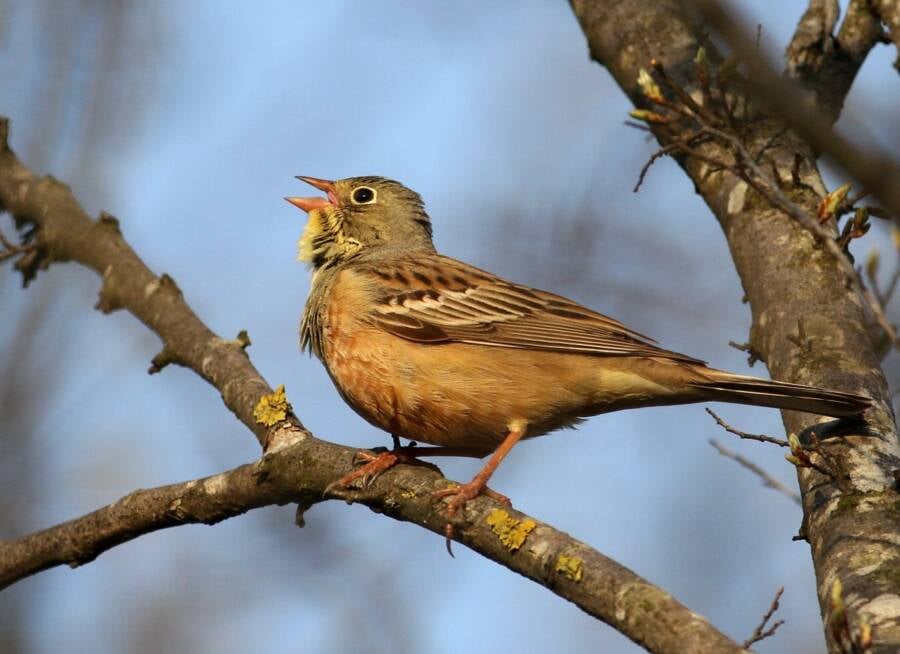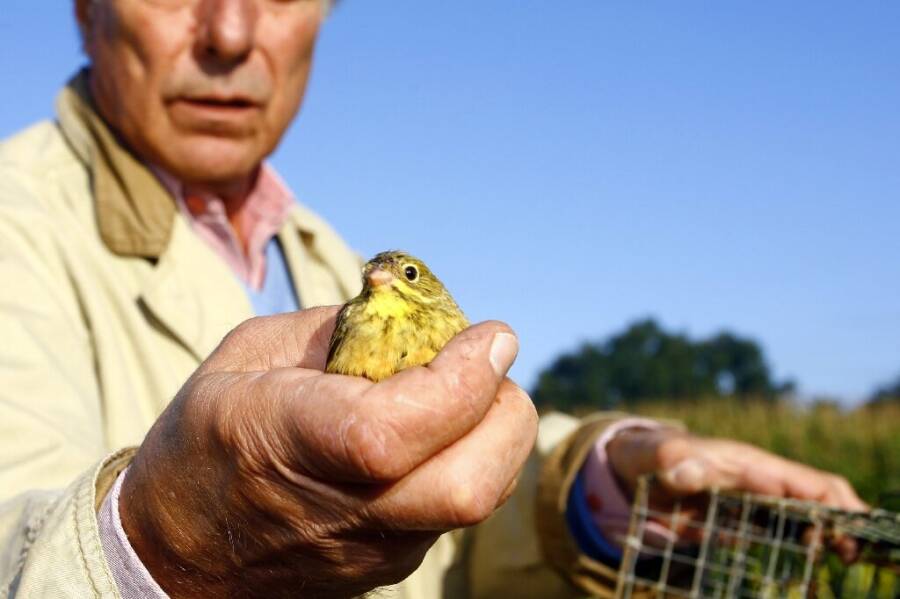Captured ortolan buntings are kept in dark cages, force fed figs and millet until they've doubled in size, drowned in brandy, plucked, roasted, and eaten feet-first in a single bite, leaving just the beak behind.

Andrej Chudy/Wikimedia CommonsThe ortolan, also known as the ortolan bunting, is sought after as an illicit delicacy.
There’s a tiny bird in Europe that’s not known for its song or striped feathers but rather for its mouthwatering, sinful taste. The ortolan is purportedly so scrumptious that people put a napkin over their heads as they feast on the creature so that they can block out all other sights and sounds.
But that’s just one reason why diners cover themselves with a napkin. The other is to hide their faces out of shame. After all, the orlotan’s journey from deep in the woods to the dinner plate is a torturous one. It involves the bird being blinded, force-fed, and drowned in brandy.
Despite this — and despite the fact that trapping ortolans is forbidden in the European Union — the birds remain a sought-after delicacy. In recent years, they’ve come to represent an illicit and exclusive dish reserved for those who know where to find it (or with the capital to pay someone who does). On shows like Succession and Billions, ortolan has been used to represent the rare experiences available only to the very wealthy.
So, how did this little songbird become such a big deal?
Ortolan Eating: How To Prepare And Consume The Bird
The ortolan, also known as the ortolan bunting, is a tiny songbird that can be found in Western Europe and parts of Asia and Africa. Since Roman times, ortolan eating has been considered the ultimate delicacy.
But it takes several gruesome steps to prepare the bird.
First, hunters in France lay nets called matoles in order to trap the birds as they migrate south. Because ortolans look for food at night, they’re kept in dark cages for three weeks to trick them into eating grains and figs nonstop. (Some ortolans are allegedly blinded to achieve this effect).
Once the birds have doubled in size, they’re drowned in Armagnac brandy, plucked, roasted, and plopped onto a plate. Then, diners place a napkin over their heads, pick up the ortolan, and consume it feet-first in one bite, eating every part — including bones — except for the beak.

Marianne Casamance/Wikimedia CommonsA napkin-covered diner preparing to eat ortolan.
“It is enveloped in fat that tastes subtly like hazelnut,” French chef Michel Guérard told The New York Times in 2014, “and to eat the flesh, the fat and its little bones hot, all together, is like being taken to another dimension.”
Celebrity chef Anthony Bourdain offered a similar description, telling Stephen Colbert in a 2011 interview: “It’s sort of a hot rush of fat, guts, bones, blood and meat, and it’s really delicious.”
The ortolan’s taste and the ritual around preparing and eating it have made it a sought-after specialty. But that’s not the only reason. Ortolan is also coveted because it’s almost impossible to find today.
How The Songbird Became A Sinfully Sought-After Dish
In 1979, the European Union banned the hunting of the ortolan and deemed it a protected species. But in places like France — where the rule was not initially enforced — this only fueled the dish’s desirability.
Ortolans became expensive, rare, and highly coveted. When former French President François Mitterrand lay dying on New Year’s Eve in 1995, he reportedly enjoyed a lavish final meal that included not one but two ortolans (consumed, of course, under a napkin).
In 1997, The New York Times reported about a secret dinner in France where diners feasted on “forbidden foods,” including ortolans. Though some participants described the meal to the newspaper, others denied that the songbirds had been eaten at all.
When one diner compared eating the birds to adultery, another laughingly told a reporter: “Adultery! It has been in France forever. The husband does it; the wife does it. Everyone knows it and does it. Just like ortolan.”
In more recent years, shows like Billions and Succession have used ortolan to represent extreme wealth. In the Billions episode “The Third Ortolan,” one character feasts on the songbird and raves: “I don’t know about you but I just had a religious experience. At the climax I felt the crack of its little rib cage, then the hot juices rushing out, down my gullet. Sublime.”
In the Succession episode “Which Side Are You On?”, one character tells the other: “This is like a rare privilege. And it’s also kind of illegal.”

HBOSuccession character Tom Wambsgans (Matthew Macfadyen) holding up an ortolan with his head covered by a napkin.
But even though France officially banned the hunting of ortolans in 1999, this was not strictly enforced until almost a decade later. And conservationists today remain concerned about how illicit trapping of the songbird could decimate the species.
The Decline Of The Ortolan
In 2019, a study published in Science Advances found that ortolans were still being hunted. Of the 300,000 that migrated through France, some 30,000 were trapped.
“If hunting of the ortolan continues, it will lead to the ortolan’s disappearance,” Frédéric Jiguet, a professor at France’s National Museum of Natural History and the study’s main author, said in 2019, according to Smithsonian Magazine. “Removing 30,000 birds each autumn from the population crossing France constitutes a significant contribution to the decline of the species.”
A previous study in 2016 found that the number of ortolans migrating across France had plummeted some 20 to 30 percent between 2000 and 2014.
This has put conservationists at odds with gourmet chefs, who argue that the ortolan belongs to the French culinary tradition.
“There are many things that we eat that are not essential to live,” celebrity French chef Jean Coussau remarked to The New York Times in 2014. “We could survive on nutritional pills if we had to. But if we go down that path, the notion of pleasure will disappear.”
In the same article, Allain Bougrain Dubourg, the president of France’s Birds Protection League, pushed back against the notion of tradition.

Science AdvancesAllain Bougrain Dubourg releasing an ortolan that was found caught in a cage in 2009.
“These chefs are totally backward; they are not living in the 21st century,” Dubourg said. “They aren’t doing this for gastronomy. It’s all about raising their profile.”
Despite this, ortolan continues to be a coveted dish — but good luck tracking it down. Today, the scrumptious songbird remains as elusive as ever.
After reading about the ortolan, discover the ugly truth behind shark fin soup. Or learn about shirako, the Japanese delicacy made of cod fish sperm.





